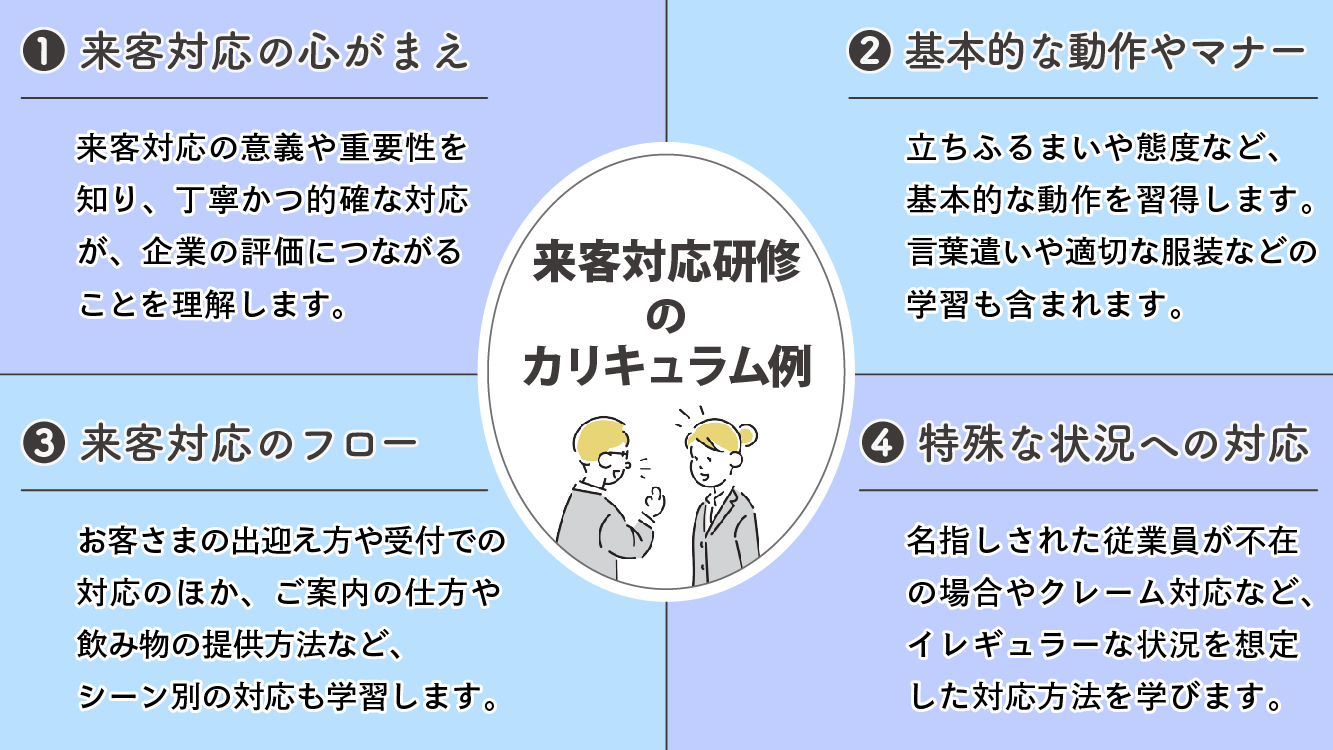2024.06.14
Is customer service training necessary for newcomers? What are the necessary responses as business etiquette?

In a business setting, responding to visitors is one of the important tasks that determines the company's impression. Without knowing the basics of visitor reception, there is a possibility of making unexpected rudeness or mistakes, which could later affect business negotiations or lead to troubles. Therefore, for inexperienced newcomers in particular, training on visitor reception is essential.
In this blog, we will explain the importance of visitor reception training, its basic content, and key points to enhance the effectiveness of the training.
Table of Contents
1. Importance of New Employees Receiving Customer Service Training
2. Basic Content of Customer Service Training
3. Key Points to Enhance the Effectiveness of Customer Service Training
4. Benefits of Conducting New Employee Training through E-Learning
5. How to Cover the Disadvantages of E-Learning
6. Conclusion
1. The Importance of New Employees Receiving Customer Service Training

First, let's organize what visitor reception refers to.
●What is Visitor Reception?
Visitor reception refers to a series of response tasks conducted for customers visiting a company. Specifically, it includes the following content.
(1) Welcome and Reception
Welcoming customers with a smile at the reception and entrance, confirming their names and purpose of visit. For customers with appointments, we will notify the designated employee of their arrival.
(2) Guidance
We will guide customers to the designated rooms such as the reception room or conference room. During this time, we will walk about 2 to 3 steps ahead of the customer, being mindful of the pace.
(3) Hospitality
We provide beverages such as tea and coffee, paying attention to ensure that our customers can spend their time comfortably.
(4) Greetings
We strive to offer polite greetings and introduce ourselves when meeting for the first time. We will exchange business cards as necessary.
(5) Customer Inquiry Response
If there are any questions or inquiries from customers, we will respond quickly and accurately. If it is necessary to contact the person in charge, we will pass on the details.
After the visit, we will escort the customer to the entrance or exit. We may also provide information about the next visit or future communications.
These are just examples, and the responses may vary by company. While they may seem trivial, visitor reception directly impacts a company's impression, reliability, and customer satisfaction. In other words, it is not an exaggeration to say that employees entrusted with visitor reception interact with customers as "representatives of the company." Therefore, it is significant for new employees who have just entered the workforce to receive training in visitor reception.
Below, I have summarized the benefits of new employees receiving customer service training.
●Benefits of New Employees Receiving Customer Service Training

(1) Acquire Business Etiquette
By attending customer service training, you can learn the basic business etiquette. By mastering the correct business manners, you convey respect to your customers and build a trusting relationship.
(2) Gain confidence in interacting with customers
By learning how to handle visitors, you can interact with customers confidently. As a result, you will be able to provide more attentive and courteous service, giving customers a sense of reassurance.
(3) Can Prevent Troubles from Occurring
By learning the basics of customer service, you can acquire the skills to appropriately handle various situations. This can help prevent troubles from occurring and reduce the burden of handling complaints.
(4) Leads to an Improved Corporate Impression
Customer reception is often the first opportunity for clients to interact with the company. If handled appropriately, it can enhance the company's first impression and improve its reputation and image.
(5) Consistent Response
By having all employees undergo the same visitor response training, consistency in visitor handling is achieved. As a result, customers can receive the same high level of service from any employee. This, in turn, enhances trust in the entire company.
By having newcomers undergo customer service training in this way, it has been understood that not only does it contribute to the personal development of the newcomers themselves, but it also leads to an overall improvement in the company's performance.
2. Basic Content of Visitor Reception Training
In this chapter, we will explain the specific content of the visitor reception training. Generally, the following curriculum is provided.
●Example Curriculum for Visitor Reception Training

(1) Attitude Towards Customer Reception
Understanding the significance and importance of customer reception, and recognizing that polite and accurate responses to customers lead to the company's reliability and evaluation.
(2) Basic Actions and Manners
Learn basic actions that create a good impression, such as behavior and attitude, and proper manners that show respect to customers. This also includes learning about language use such as honorifics, appropriate attire, expressions, and how to make eye contact.
(3) Visitor Reception Flow
You will learn how to greet customers, handle reception duties, and exchange business cards. Additionally, you will learn how to guide them to designated areas, as well as the timing and methods for serving drinks, tailored to different scenarios.
(4) Response to Special Situations
By anticipating irregular situations, such as complaints from customers or the absence of a specifically named employee, you can feel more secure. Additionally, for companies with many visitors from overseas, it is also beneficial to learn how to greet customers in their preferred language and to consider examples of cultural differences.

Through this curriculum, newcomers can acquire the knowledge and skills necessary for customer service.
3. Key Points to Enhance the Effectiveness of Visitor Reception Training

To enhance skills in customer service, it is important not only to input the curriculum content introduced in the previous chapter as knowledge but also to internalize it through practical programs such as role-playing.
Therefore, I have summarized the key points for conducting more effective visitor reception training.
Point 1: Engage in Role-Playing to Acquire Practical Skills
By conducting role-playing that simulates actual work scenarios, you can acquire not only theoretical knowledge but also practical skills. Additionally, by anticipating various situations and troubles, your problem-solving abilities will also be enhanced.
Point 2: Provide Feedback
After role-playing, let's provide specific feedback. By communicating what was good and what should be improved, we can deepen the understanding of learning. Additionally, by offering positive words when done well, newcomers can gain confidence. Accumulating such successful experiences will also enhance motivation for learning and work.
Point 3: Communicate the training objectives and the benefits gained
Before starting the customer service training, setting the training objectives clarifies the direction of learning. Additionally, communicating the benefits of the training can lead to an increase in learners' motivation.
Point 4: Conduct a Demonstration as a Model
By having instructors or senior employees demonstrate actual customer interactions, newcomers can more easily form a concrete image. It is even more effective to show both good and bad examples.
Point 5: Participate in Actual Customer Interactions
As part of the training, we will allow new employees to participate in actual customer interactions alongside senior employees, gaining practical experience. Start with observation and gradually increase the situations where the new employees take part.
We recommend conducting regular follow-up training instead of just a one-time session. By repeating the training, the anxiety and tension of newcomers can be alleviated, and skill retention can be achieved. As a result, they will be able to perform effectively in actual work situations.
Additionally, it is effective to prepare manuals and resources so that new employees can check the visitor handling procedures at any time.
4. Benefits of Conducting New Employee Training through e-Learning
In the past, when it came to new employee training, group training conducted in a single location was common. While group training has the advantage of allowing for immediate feedback and communication with instructors, it also faced challenges in terms of time and cost.
Recently, there has been growing attention on "high-quality and efficient training for new employees" utilizing e-learning. Here, we will explain the benefits of conducting new employee training through e-learning.
Merit 1: Learn Anytime, Anywhere
E-learning allows employees to learn without being constrained by time or location, accommodating each individual's schedule. Additionally, it is compatible with mobile devices such as smartphones and tablets, which are familiar to younger generations, making it easy for newcomers to engage in learning.
Benefits.2 Reviewable as many times as needed
e-learning is different from one-time group training, as it allows for repeated participation, enabling thorough repetitive learning until understanding is achieved. This seems to be a reassuring tool, especially for newcomers who have a lot to memorize.
Merit 3: Standardization of Education
In the case of group training, there is a possibility of variation in the "quality of education" depending on the instructor. However, with e-learning, the same educational content can be provided to all participants, leading to the standardization of education.
Merit 4: Easy Learning Management and Optimal Education Provision
E-learning delivery and participation are primarily conducted using an LMS (Learning Management System). This LMS records all data such as learning progress and grades, making learning management easy. Additionally, based on the data, tests can be conducted and surveys can be taken, allowing for the provision of optimal education tailored to each individual newcomer.
Merit.5: Leads to Cost Reduction
E-learning is a form of online learning, which eliminates the need for guarantees for instructors, venue costs, and travel expenses for participants. For example, when conducting group training for all new employees in a company with branches nationwide, costs such as travel and accommodation to the venue may arise. However, with e-learning, these expenses are not incurred, allowing for significant cost savings.

In this way, e-learning can provide many benefits that traditional training styles do not offer, such as flexibility in learning, improved learning effectiveness, and cost efficiency.
5. How to Cover the Disadvantages of e-Learning

E-learning is effective for new employee training, but there are aspects of practical experience that it cannot cover. Therefore, we will introduce methods to supplement that.
●Utilize as a hybrid training method
Learn foundational knowledge and theory through e-learning, and conduct role-playing with the cooperation of your workplace supervisors and senior employees for practical application. By applying the knowledge gained from e-learning in a real environment, skills can be solidified, and the ability to respond flexibly can be developed.
●Add Interactive Elements
By adding interactive videos and game-like content to e-learning, learners' motivation increases, allowing them to engage more actively in their studies. For example, when a video demonstrating good and bad examples is included, comparing both makes it easier to clearly understand the results and visualize specific response methods.
●Use as a repetitive learning tool
E-learning, which can be easily accessed anywhere, is ideal as a tool for repetitive learning and review. Using e-learning to reconfirm the knowledge and experiences gained through role-playing serves as a "reflection space," leading to a deeper understanding and retention of knowledge.
By combining different learning methods, such as acquiring basic knowledge and repetitive learning through e-learning, and practical learning through role-playing, learners can achieve a balanced understanding of both theory and practice.
6. Summary

Visitor reception, which determines the first impression of a company, is one of the most important business skills. Additionally, learning the basics of visitor reception leads to improved communication skills both inside and outside the company, making it a skill that newcomers should acquire early on. Therefore, training for newcomers on visitor reception can be said to be essential for companies.
To make such visitor response training more effective and efficient, we recommend the e-learning mentioned above.
Human Science offers a variety of e-learning materials to support the early empowerment of new employees. One of these, "Basic Business Etiquette: Visitor and Visit Edition," clearly explains the fundamental methods of handling visitors, client visits, and business card exchanges.
For more details, please refer to the e-learning site of Human Science Co., Ltd.
>e-Learning Material "Fundamentals of Business Etiquette: Guest and Visit Edition"
We hope to contribute to improving customer service skills so that new employees who support the future of the company can thrive with confidence.












